Rick's b.log - entry 2023/10/16 |
| ||||||
mailto: blog -at- heyrick -dot- eu
You are not reading my b.log using HTTPS. You can switch to HTTPS by clicking here. Brrr!Autumn has come quickly. It was brass bloody monkeys this morning. Not quite a frost, but not far off. The first day I felt that I needed a coat outside.On my coat stand I have a nice selection of black coats, so I thought I'd pick a black one. ☺ I did some work with my sequencer, so there's yet another incarnation below, and I did some other stuff too.
Curtain and lightIt's getting to be the time of the year when the shutters need to be closed. Firstly because it gets dark quickly, and secondly because it helps prevent the windows from misting up on the insides.If I have the shutters closed, and it is dark outside, even though I live in the back of nowhere I worry about people looking in. Moreso that they could see me but I'd not be able to see them. Therefore, to afford a better level of privacy, I have fitted a 'curtain' to the front door. It's actually a piece of gingham-ish fabric folded over. I think it was intended to be a tablecloth or something. It was fitted by simply whacking some drawing pins into the door.  Shutters and curtain.
Since the shutters are now going to likely be closed a lot (like when I'm at work), I can't leave the solar panel for the LED lamp on the table. What to do? 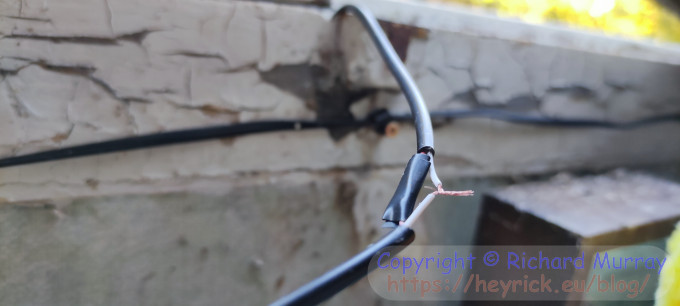 Reattaching the wires. Now the solar panel can sit on the windowsill.
It isn't hermetic. The casing is just screwed together, and the wire passes through a hole in the back of the casing larger than it needs to be. So in order to try to protect the circuitry from corrosion (as often gets these LED lamps), I gave it a coat of nail varnish.  Nail gloss - this stuff is expensive!
Anyway, the point was to cover the dinky little circuit board with an electrically inert stuff that should dry to form a waterproof coating to protect it from eventual corrosion from the damp. 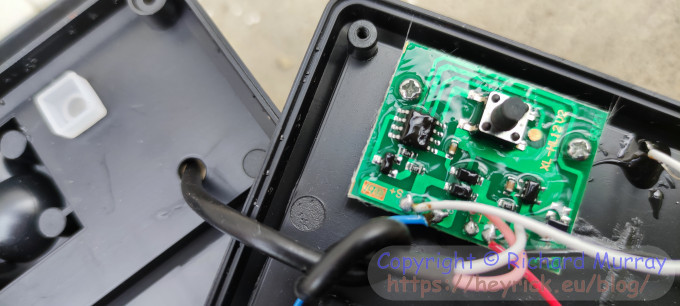 A gloss-coated circuit board.
Walking AnnaI lined up some bits of chewy stick on the wall. A little treat for Anna to find. I think she understands "wall, Anna" to mean to climb up on that hard thing and look for the food. Which is exactly what she did.  "I'll just inhale this stuff".
We did a walk around the house, where she rolled in the dirt of the potato patch that I rotovated on Saturday, then in a pile of grass cuttings from where I mowed on Saturday, then rolling on the beaten earth floor of the hangar... she damn near turned herself into a basic brown tabby cat. It'll take a lot of licking to clean herself up.
Auditing Pig and a teardownAs it warmed up in the late afternoon, I decided to clean and audit Pig to check that the figure showing on the display was accurate.No, not Some Pig (the smaller mower), my piggy bank...  There's supposed to be €542,63 in here. It meant sorting the change into piles of €10, then €1. I had two bags of one centime pieces. 100 in one bag, and 97 in the other. I just put three loose centimes on top of the 97 to make up a euro. I didn't put them in the bag as it had "97" written on it and I couldn't be bothered to go fetch a marker.  Small piles.
I've not fed Pig recently, as these days most stuff is pay-by-bonk so I don't have change in my pocket. It turns out that I was only sixty one centimes out. This could easily be explained by glitches in the thing reading the size of the coins. If, for example, it reads €0,20 for a ten centime piece? 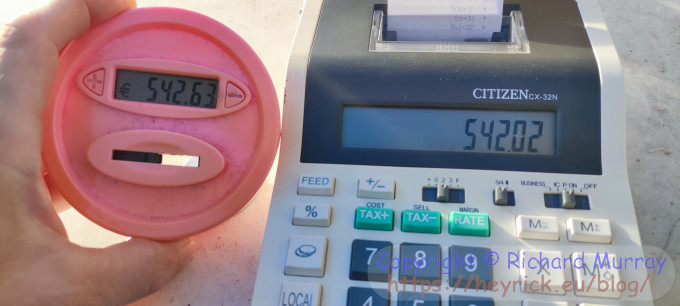 It was mostly correct. Since I was cleaning it, that meant taking it apart. So time for a teardown... Here's the main board. 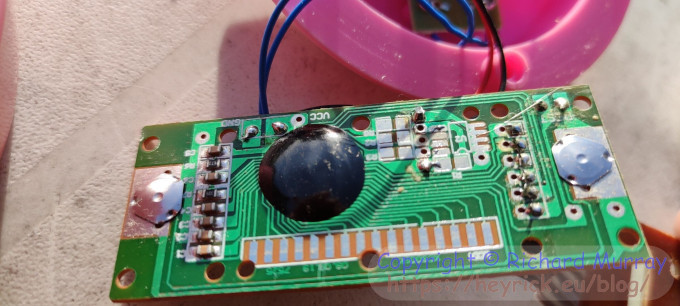 The main board.
The contacts in the foreground are for one of those rubber strips for connecting to LCDs. The two buttons are for adjusting the amount (plus and minus). The row of soldered connections go to the coin detection board.
What struck me was that there wasn't any method of selecting the currency, but then I realised that there doesn't actually need to be. Both £ and € have coins that represent 1, 2, 5, 10, 20, 50, 100, and 200. So all you'd really need is to have a different LCD (mine only has a € symbol) and the appropriate matching coin detection board. This is the detection board. 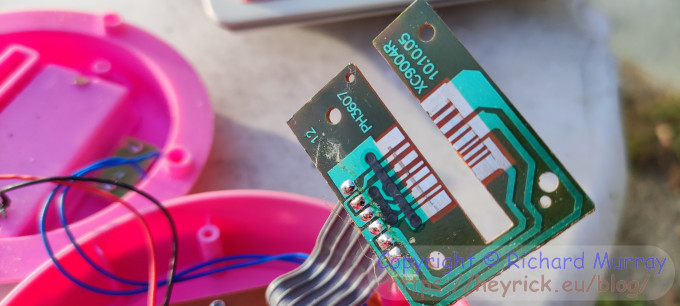 The detection board.
The uppermost position is the home position. You can see this is where the worn part ends. Here's the logic table for how the coins are detected.  Everything was reassembled, the coin slot tested with a few coins, and then the count corrected.
The BBC is clearly not biasedThe BBC has received a little over 1,500 complaints about its coverage of the current cluftersuck that is the Israel-Palestine situation. Almost exactly half have complained that the coverage is biased towards Israel, while the other almost exactly half have complained that it favours Palestine.So if both sides are complaining equally, then clearly the BBC is neither biased against nor preferring one country over another.
There's probably also a lesson here about people's dispositions having them see and hear what they want to hear rather than what was actually said. Perhaps worth remembering the next time a politician (or, worse, right wing hack) talks about how the BBC is biased.
SimpleSeq v0.14No, there's no thirteen. There never is. ☺In this release, I have done a few things that I've been wanting to do for a while.
The first thing is internal. I have purged all of the sprintf() calls and replaced them with snprintf(). Likewise most of the calls to strcpy() and strcat() have been replaced with calls to strncpy() and strncat() (not all of them, there doesn't seem much point when placing a fixed twenty character string into an eighty character buffer...).
While this is a nonsense in the world of RISC OS (there's a simple SWI that will give anybody kernel level privilege!), it's always worth taking some time to try to minimise the risk of having buffer overrun issues. Especially in RISC OS where it is unfortunately rather unlikely that the offending function will crash. Instead, all too often, something else somewhere else will fall over and you'll be on an epic bug hunt to try to track down the problem.
The next change was to support loading files by them being double-clicked upon. This isn't actually 'working' as I don't yet have a filetype allocation (I only asked for it this past lunchtime), however the loader mechanics now work. %Set File$Type_123 SimplSeq %Set Alias$@RunType_123 Run <SimpleSeq$Dir>.!Run -load %%*0 And then change the final line to say: Run <SimpleSeq$Dir>.<SimpleSeq$Program> %*0 Yes, it's correct that the Alias command has percent-percent-star-zero while the command that actually runs the program only has percent-star-zero.
Now if you set the files to type &123, double-clicking them will cause the program to run and the music to appear in the editor.
If, instead, you pass the command line option  I fixed the little bar that sweeps across as the music is played. The first fix was to make it work correctly in quaver mode (including, now, a half-width bar that exactly follows the music being played), and perhaps more usefully than most of us, it will no longer keep jumping back to the left of the screen with every bar (imagine what it was like in 2:4 time!). Now it will sweep across the screen so long as there is a whole bar visible, only jumping back to the left when there are no more whole bars on-screen. The final change? An itty bitty addition to the Save dialogue.  Did you spot it? The new "Save file compressed" option?
The header, music setup, and editor state arrays are not compressed, but the music data can be. It goes without saying that compressed files won't be usable on previous versions of SimpleSeq. Oh, whoops, I just said it. ☺
Internally, it's just making use of the Squash module so it is extremely quick to compress and decompress. Here's the download: Download simpleseq_014.zip (117.23K)
For RISC OS 5 machines with MIDI
Your comments:Please note that while I check this page every so often, I am not able to control what users write; therefore I disclaim all liability for unpleasant and/or infringing and/or defamatory material. Undesired content will be removed as soon as it is noticed. By leaving a comment, you agree not to post material that is illegal or in bad taste, and you should be aware that the time and your IP address are both recorded, should it be necessary to find out who you are. Oh, and don't bother trying to inline HTML. I'm not that stupid! ☺ ADDING COMMENTS DOES NOT WORK IF READING TRANSLATED VERSIONS.
|
(Felicity? Marte? Find out!)
📺 The SIBA stories 📹
It's a simple substring match.
Last read at 01:28 on 2024/05/02.


| |||||||
| Next entry - 2023/10/17 Return to top of page |
| © 2023 Rick Murray |
| Retrieved from http://heyrick.eu/blog/index.php?diary=20231016 on 2nd May 2024 |


